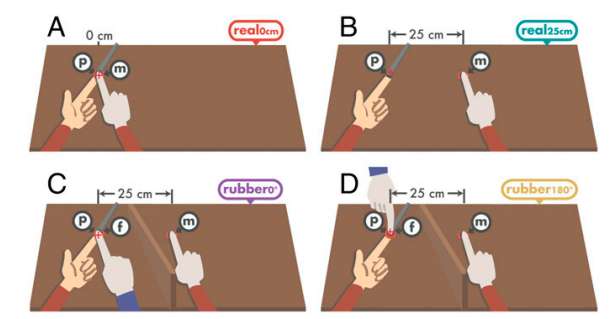July 18, 2017 report
Experiments suggest body ownership causes weakening of self-generated tactile sensations

(Medical Xpress)—A pair of researchers with Karolinska Institutet in Sweden has found that the human mind's perception of ownership of body parts is responsible for the weaker response we feel touching ourselves (sensory attenuation), compared with being touched by others or other external objects. In their paper published in Proceedings of the National Academy of Sciences, Konstantina Kilteni and H. Henrik Ehrsson describe experiments they conducted with volunteers that offered insights into the nature of brain/body ownership and sensations.
Most people know that it feels different being touched by another person than if you touch yourself, but this phenomenon has not been fully explained. In this new effort, the researchers started with prior evidence from other studies investigating the "rubber hand illusion."
The rubber hand illusion was discovered approximately a decade ago when a team of researchers found that people could become convinced that a rubber hand laying on a table in front of them was their own if both their real hand and the rubber hand were touched in the same ways at the same time. In this new effort, the researchers used the rubber hand illusion, but in conjunction with a sensation measuring technique.
Forty-eight volunteers between the ages of 20 and 37 were subjected to a variety of sensory experiments. Overall, the experiments were designed to show whether a person who had been induced to believe a rubber hand was their own experienced the same degree of sensation when their hand or the rubber hand was touched. The experiment was designed to explore whether the mind's perception of ownership of a hand causes reduced sensation, or whether it was something more physical.
Individually, the experiments entailed conducting the rubber hand illusion while also conducting what is known as the force-matching paradigm, in which psychophysical quantification of somatosensory attenuation is measured.
The researchers found that if a volunteer had a right rubber hand pressing against their real index finger, it produced attenuation—but only if the rubber hand felt like it was the person's real hand. Conversely, they found that expected attenuation due to self-touching was reduced if the volunteer experienced false ownership of a rubber hand right hand some distance from the left hand.
Results such as these, the researchers claim, show that it is the mind's perception of body ownership that causes attenuation of sensation during self-touching to occur.
More information: Konstantina Kilteni et al. Body ownership determines the attenuation of self-generated tactile sensations, Proceedings of the National Academy of Sciences (2017). DOI: 10.1073/pnas.1703347114
Abstract
Self-perception depends on the brain's abilities to differentiate our body from the environment and to distinguish between the sensations generated as a consequence of voluntary movement and those arising from events in the external world. The first process refers to the sense of ownership of our body and relies on the dynamic integration of multisensory (afferent) signals. The second process depends on internal forward models that use (efferent) information from our motor commands to predict and attenuate the sensory consequences of our movements. However, the relationship between body ownership and sensory attenuation driven by the forward models remains unknown. To address this issue, we combined the rubber hand illusion, which allows experimental manipulation of body ownership, and the force-matching paradigm, which allows psychophysical quantification of somatosensory attenuation. We found that a rubber right hand pressing on the left index finger produced somatosensory attenuation but only when the model hand felt like one's own (illusory self-touch); reversely, the attenuation that was expected to occur during actual self-touch with the real hands was reduced when the participants simultaneously experienced ownership of a rubber right hand that was placed at a distance from their left hand. These results demonstrate that the sense of body ownership determines somatosensory attenuation. From a theoretical perspective, our results are important because they suggest that body ownership updates the internal representation of body state that provides the input to the forward model generating sensory predictions during voluntary action.
© 2017 Medical Xpress

















